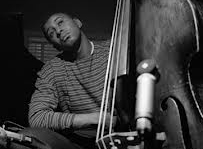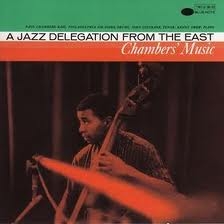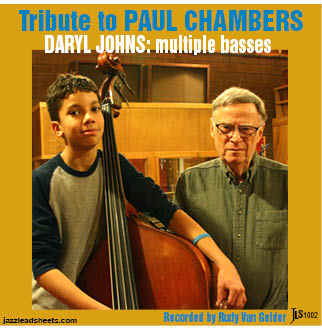Visitation – Paul Chambers
Paul Chambers' classic line on the changes of All God's Chillun Got Rhythm. In addition to our lead sheet editions and transcription of Paul's solo, we have two separate Minus You versions available, both featuring young bass star Daryl Johns.
- Recording: Paul Chambers - Chambers' Music
- Recorded on: March 2, 1956
- Label: Blue Note (CDP7-84437)
- Concert Key: F
- Vocal Range: , to
- Style: Swing (medium)
- Piano - Kenny Drew
- Bass - Paul Chambers
- Drums - Philly Joe Jones
Purchase Visitation - Paul Chambers
Purchasing this song through our affiliate links with certain retailers provides jazzleadsheets.com with additional support to help keep us bringing you the best lead sheets available. Thank you!
Video
- Description
- Historical Notes
- Solos
- Piano Corner
- Bass Corner
- Drum Corner
- Guitar Corner
- Inside & Beyond
- Minus You
Our audio excerpt starts with the four-measure drum intro that sets up the melody. Paul plays the whole melody alone on bass, accompanied only by Philly Joe's brush work, which works great, but other instrumental artists have enjoyed doubling the melody in octaves with the bass.
The first measure of the B and D sections has often been misinterpreted with a couple of different notes, notably D instead of E on the "and" of the fourth beat; our lead sheet presents the melody as played by Chambers on the original recording. Paul's recording was on a small label, and therefore not widely distributed. Bassist Sam Jones was the next to record it, and he arranged Paul's melody differently in places. Paul's publisher for this composition was initially Horace Silver, and he gave us a copy of the manuscript that was filed for copyright in 1956. However, many times there's a difference between how a song is written down on paper and how it's actually played. That's what happened here.
A transcription of Chambers' bass solo is available; click on the Solos tab for more details.
Click on the other album covers for our two Minus You versions.
The trio heard on this track recorded again in September of the same year on Drew's trio album for Riverside (check out Weirdo from this album), recorded at Rudy Van Gelder's studio in Hackensack, New Jersey. Drew, Chambers and Jones were also the rhythm section for three additional widely revered albums: Coltrane's "Blue Train" in 1957, and in 1961 Kenny Dorham's "Whistle Stop" and Dexter Gordon's "Dexter Calling."
The solo transcription also includes the in and out heads. Check out the Miinus You version!
Notable fingerings have been added to provide clarity in regards to how to tackle this piece. When boldface letters D G A and E are seen under the fingering, this indicates that the notes over these letters are to be performed on that string.
Related Songs
Email Send Visitation to a friend
- Recording: Don Sickler - Don Sickler Quartet featuring Daryl Johns
- Recorded on: January 31, 2010
- Label: jazzleadsheets.com (JLS 1001)
- Concert Key: F
- Vocal Range: , to
- Style: Swing (medium)
- Trumpet - Don Sickler
- Piano - Michael Cochrane
- Bass - Daryl Johns
- Guitar - Steve Johns
Video
- Description
- Historical Notes
- Solos
- Piano Corner
- Bass Corner
- Drum Corner
- Guitar Corner
- Inside & Beyond
- Minus You
This track is available in a Minus You format so any instrument can play along with the audio—click on the Minus You tab for more details. Drummers should get the C lead sheet.
This track comes from the same session as our other bass feature Minus You quartet recordings: The Plain But The Simple Truth, Ease It, and Bet.
Though Paul Chambers only recorded Visitation in a trio setting with solo bass melody, some other songs from his albums have him playing the melody in octaves with horns as in this version, including Charlie Parker's Dexterity from "Chambers' Music" as well as Ease It from Paul's "Go" album. Bassist Sam Jones recorded Visitation in this setting, playing the melody in octaves with tenor saxophonist Bob Berg on his album Visitation
Our quartet version is melodically slightly more similar to Jones' version, especially with regard to the first measure of the B and D sections (click on the Description tab for the first recording pictured above for more details).
-- count off 2 measures
-- pick up into melody—play melody in unison with bass
-- solo instrument break (2 measures at end of head) into solo
-- solo (accompanied by piano, bass and drums) [2 choruses]
-- solo (accompanied by bass and drums) [2 choruses]
-- solo (accompanied by piano and brushes) [2 choruses]
-- out melody—play in unison with bass
MP3 minus piano [clip]
-- count off 2 measures
-- comp for the melody
-- comp for the trumpet solo [2 choruses]
-- solo (accompanied by bass and drums) [2 choruses]
-- comp behind bass solo [2 choruses]
-- play the head out
MP3 minus bass [clip] (there is a separate Bass part edition)
-- count off 2 measures
-- play the melody in unison with trumpet
-- walk for the trumpet solo [2 choruses]
-- walk for the piano solo [2 choruses]
-- solo (accompanied by piaho and brushes) [2 choruses]
-- play the head out in unison with trumpet
MP3 minus drums clip Drummers should get the C lead sheet.
-- count off 2 measures
-- comp for the melody - brushes (switch to sticks during the solo break at the end of the head)
-- comp for the trumpet solo [2 choruses]
-- comp for the piano solo (sticks) [2 choruses]
-- comp for the bass solo (brushes) [2 choruses]
-- play along with trumpet and bass on the head out—stay on brushes
As recorded by Don Sickler Quartet featuring Daryl Johns CLIP
-- melody
-- instrumental solo (trumpet on recording) [2 choruses]
-- piano solo [2 choruses]
-- bass solo [2 choruses]
-- out melody
Related Songs
Email Send Visitation to a friend
- Recording: Daryl Johns - Tribute to Paul Chambers - Daryl Johns: multiple basses
- Recorded on: May 29, 2010
- Label: jazzleadsheets.com (JLS 1002)
- Concert Key: F
- Vocal Range: , to
- Style: Swing (medium)
- Multiple Basses - Daryl Johns
Video
- Description
- Historical Notes
- Solos
- Piano Corner
- Bass Corner
- Drum Corner
- Guitar Corner
- Inside & Beyond
- Minus You
This track is also available in a Minus You setting—a unique opportunity to play along with multiple basses and to practice soloing over a walking bass. Click on the Minus You tab for details.
Also from this session with Daryl Johns are Ease It and Tempo Di Max.
Don Sickler: Daryl had recorded Visitation with me a few months before, when we played it at a faster medium swing tempo, almost the same tempo that Paul originally used. For the four basses arrangement, I wanted to create a different groove. As I started hearing three-bass answering figures for the spaces in the melody, I started feeling a slower tempo. An absolutely amazing thing about the then-thirteen-year-old Daryl was his ability to lock into a given tempo immediately. I'd just sing him the first three bars of the tempo I was hearing, and he'd immediately lock it right in. We never used a click track on any of these recordings. Playing with a click track wouldn't work with the ebb and flow necessary for this arrangement. All I needed to give Daryl was a "scratch track" part, and he'd lay down the whole initial track then build the arrangement around it, part by part.
Saxophonist Adam Kunsberg videotaped the Tempo di Max session at the Van Gelder Recording Studio—it's fun to see young Daryl doing the multiple overdubs on split screen.
You can have a lot of fun playing any of the parts along with Daryl on the recording. So far, we're only making the full audio track available. However, since these were recorded one track at a time, we could make Minus You Bass 2, Bass 3 and Bass 4 tracks available. Would you be interested? Give us some feedback.
Here is the format:
-- count off (2 measures)
-- melody—play in unison with bass(es)
-- break (2 measures) into 2 choruses of solo accompanied by walking bass
-- out melody
Related Songs
Email Send Visitation to a friend

Paul Chambers
April 22, 1935 – January 4, 1969
Bassist Paul Chambers was a leading rhythmic force in the 1950s and 1960s. He became one of the signature bassists in jazz history. Born in Pittsburgh but raised in Detroit, Chambers initially took up the baritone horn as a child. He followed suit with the tuba and didn't become interested in the string bass until 1949. Listening to Charlie Parker and Bud Powell and studying under a bassist of the Detroit Symphony Orchestra, Chambers began making headway in small bars of Hastings Street area and doing club jobs with Kenny Burrell, Thad Jones and Barry Harris. He did classical work in a group called the Detroit String Band, a rehearsal symphony orchestra. Read more...



